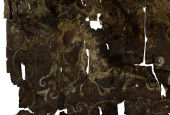-
 Korea.net's 24-hour YouTube channel
Korea.net's 24-hour YouTube channel- NEWS FOCUS
- ABOUT KOREA
- EVENTS
- RESOURCES
- GOVERNMENT
- ABOUT US
Now, for the first time, we can appreciate in one exhibition almost all of the relics from the Silla Kingdom’s (57 B.C.- A.D. 935) Cheonmachong, the Tomb of the Heavenly Horse. The Gyeongju National Museum will run a special exhibition, “Cheonmachong, the Royal Tomb of Silla,” from March 18 to June 22. The museum will unveil about 1,600 tomb relics, including ten national treasures, such as the well-known Silla gold crown, National Treasure No. 188, that was unearthed from the tomb.
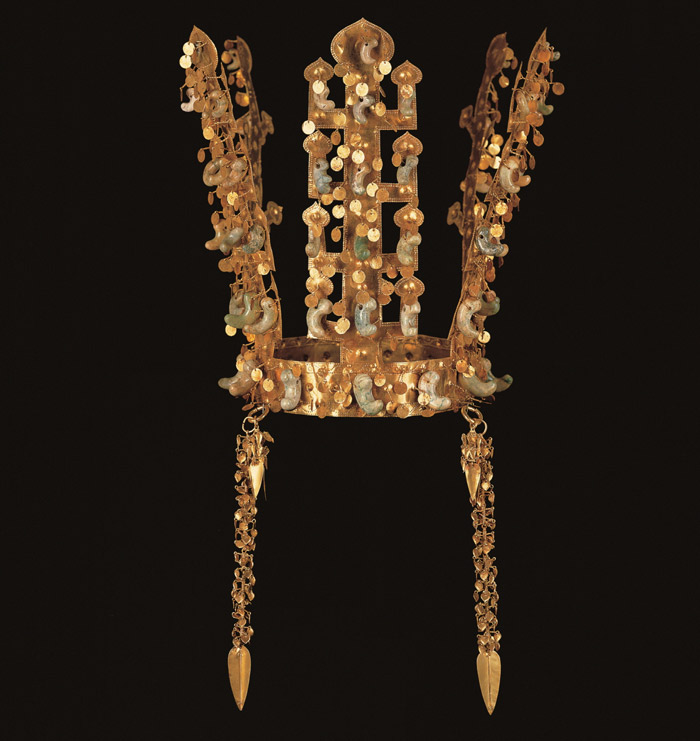
The Cheonmachong is one of most well-known tombs representing the Silla Kingdom and its nearly 1,000-year-long history. This tomb, initially dubbed as tomb No. 155, amazed not only the academic sector, but also the whole country and overseas aficionados, creating a sensation when it was first revealed to the public in 1973. The tomb got its official name, Cheonmachong, from the sets of saddle gear found therein that were decorated with flying horses.
This exhibition features some new artifacts: a birch bark plate with a horse rider, another birch bark plate with a phoenix, a saddle mudguard made of birch bark and a bamboo saddle mudguard. The two birch bark plates were originally found inside a coffer placed near the head of the tomb owner. These plates are predicted to be used as the brim of a hat, as shade, or as ornaments to decorate the horseback.
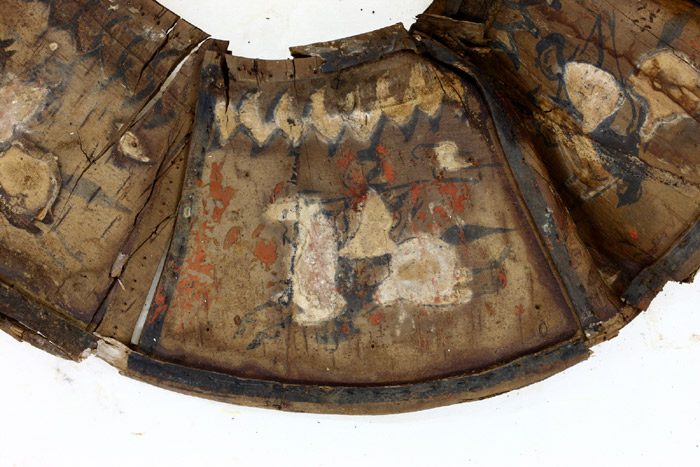
Composed of four parts, this exhibition is designed to reproduce the interior of the tomb when it was first unearthed. The first part shows a replica of a wooden coffin designed to show how it looked originally when it was unveiled. Visitors can see a gold crown, a gold cap and other golden accessories. The second part shows the tomb relics that were displayed around the coffin. Other relics on display in the second part include a sword with a phoenix-shaped ring-pommel, a saddle mudguard made of birch bark and a bamboo saddle mudguard.
The restorers found that the sword is engraved with various patterns, including a dragon, a phoenix, a lotus in gilt bronze and vine leaves. The museum revealed these saddle mudguards prior to the exhibition.
The four paintings in the second part, including the two saddle mudguards, will be open to the public separately three times from March 18 to April 6, from April 29 to May 18 and from June 2 to 22. During the last opening of the exhibition, reports from the initial 1973 excavation and related photos will be displayed.
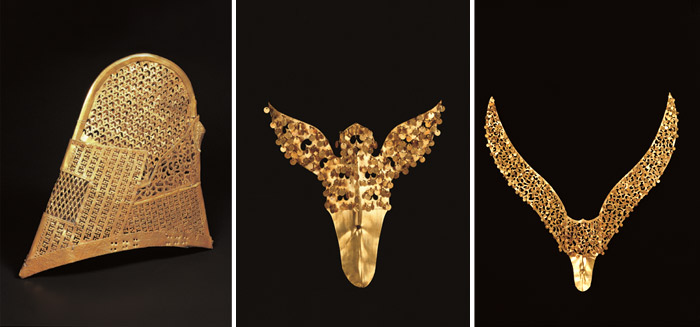
Director of the Gyeongju National Museum Yi Younghoon said, “This special exhibition shows everything from the Cheonmachong, ever since it was unearthed in 1973, with a gold crown from the Silla Kingdom and with paintings of a heavenly horse. Artifacts that were not open to public in the past will be seen here after extensive restoration works.”
By Yoon Sojung
Korea.net Staff Writer
arete@korea.kr
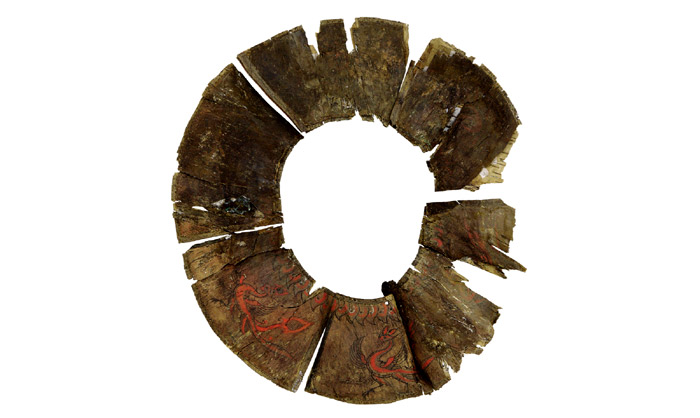
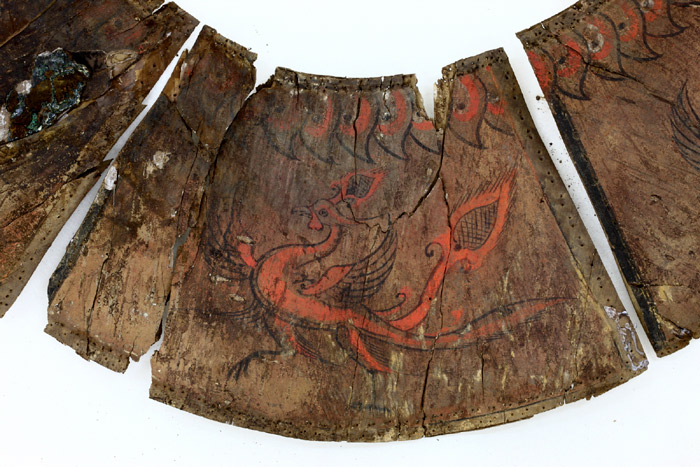

The Silla gold crown is National Treasure No. 188. (courtesy of the Gyeongju National Museum)
The Cheonmachong is one of most well-known tombs representing the Silla Kingdom and its nearly 1,000-year-long history. This tomb, initially dubbed as tomb No. 155, amazed not only the academic sector, but also the whole country and overseas aficionados, creating a sensation when it was first revealed to the public in 1973. The tomb got its official name, Cheonmachong, from the sets of saddle gear found therein that were decorated with flying horses.
This exhibition features some new artifacts: a birch bark plate with a horse rider, another birch bark plate with a phoenix, a saddle mudguard made of birch bark and a bamboo saddle mudguard. The two birch bark plates were originally found inside a coffer placed near the head of the tomb owner. These plates are predicted to be used as the brim of a hat, as shade, or as ornaments to decorate the horseback.

Details of the birch bark plate with a horse-rider painting. (courtesy of the Gyeongju National Museum)
Composed of four parts, this exhibition is designed to reproduce the interior of the tomb when it was first unearthed. The first part shows a replica of a wooden coffin designed to show how it looked originally when it was unveiled. Visitors can see a gold crown, a gold cap and other golden accessories. The second part shows the tomb relics that were displayed around the coffin. Other relics on display in the second part include a sword with a phoenix-shaped ring-pommel, a saddle mudguard made of birch bark and a bamboo saddle mudguard.
The restorers found that the sword is engraved with various patterns, including a dragon, a phoenix, a lotus in gilt bronze and vine leaves. The museum revealed these saddle mudguards prior to the exhibition.
The four paintings in the second part, including the two saddle mudguards, will be open to the public separately three times from March 18 to April 6, from April 29 to May 18 and from June 2 to 22. During the last opening of the exhibition, reports from the initial 1973 excavation and related photos will be displayed.

(Left) A gold cap, National Treasure No. 189; (center and left) gold cap ornaments. (courtesy of the Gyeongju National Museum)
Director of the Gyeongju National Museum Yi Younghoon said, “This special exhibition shows everything from the Cheonmachong, ever since it was unearthed in 1973, with a gold crown from the Silla Kingdom and with paintings of a heavenly horse. Artifacts that were not open to public in the past will be seen here after extensive restoration works.”
By Yoon Sojung
Korea.net Staff Writer
arete@korea.kr

A birch bark plate with a phoenix painting. (courtesy of the Gyeongju National Museum)

Details of the birch bark plate with a phoenix painting. (courtesy of the Gyeongju National Museum)
Related Contents
Most popular
- China warmly welcomes first Korea-born giant panda Fu Bao
- First hearing-impaired K-pop act hopes for 'barrier-free world'
- Novelist Hwang's 'Mater 2-10' shortlisted for Int'l Booker Prize
- Expats could account for 7% of population in 20 years: report
- Nat'l Fire Agency picks 137 elite staff for deployment abroad









